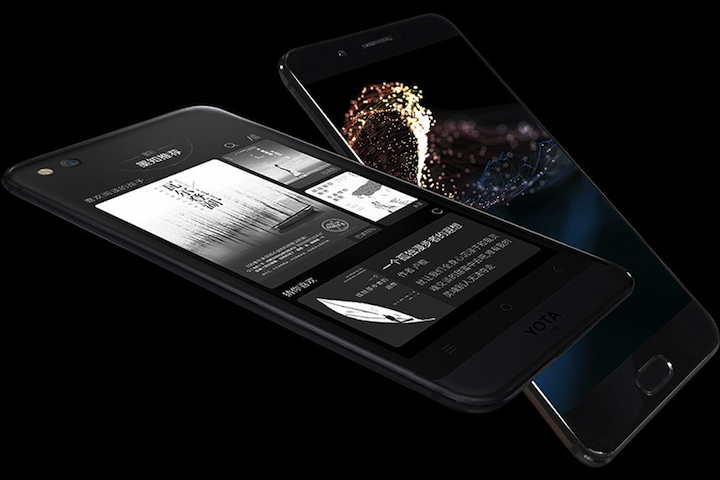
While the phone has been announced, official details and images are still filtering through. Here’s what we think we know about it.
Design
Yota phones have traditionally had two screens, a normal panel on the front, and an E Ink display on the back. The Yota 3 will have the same setup, and although the phone has been officially announced, images were less common than you’d expect. A series of press shots have now been published by the Yotaphone Club, which may give us a proper look at the device.
The front of the phone has a fingerprint sensor under the screen, and the device appears to have a metal body shell. While it looks like many other smartphones released over the past few years, the screen on the back, which measures 5.2-inches, separates it from the pack. And at first glance it’s difficult to tell which is the front and rear of the Yota 3. Under the E Ink screen is Yota’s branding, and there are Android-style software buttons to control the interface.
It’s impossible to see the thickness of the Yota 3, which has been an issue in the past, and no dimensions have been released. The press images — which haven’t come directly from Yota, and therefore may not be accurate — are flattering though, and the phone looks good.
Release and availability
The previous Yota phones have been a challenge to buy, with limited releases in varying parts of the world. Once again a wide international release for the Yota 3 seems unlikely.
Two versions are likely to be made, a $350 64GB model and a more expensive $450 model with 128GB of storage space. However, a Russian source says the Yota3 is only destined for release in China — where China Baoli has the sales rights — and in Russia around November this year. This site claims the Yota 3 will be sold in China and Russia from September, but doesn’t provide a source.
However, while Yota’s intentions are undoubtedly good, the company has struggled recently, following a no-show manufacturing partnership with ZTE, various executives including the CEO leaving the firm, and a failed crowdfunding campaign to bring the YotaPhone 2 to the United States.
Specifications
Should we be excited about the Yota 3? If you liked the previous models, then probably, as the new phone is more of the same, just a little bigger. Apparently, we should expect a 5.5-inch AMOLED screen on the front, and a 5.2-inch E Ink screen on the back, according to specs published by Engadget.
A Qualcomm Snapdragon 625 processor and 4GB of RAM is likely to power the phone, putting it squarely up against other midrange Android phones such as the Motorola Moto Z Play, and the Huawei Nova. Two screens won’t stop the Yota 3 from having two cameras. Expect a 12-megapixel camera on the back, and a 13-megapixel selfie cam on the front. Other specifications include a MicroSD card slot, and dual-SIM configuration. The phone will run Android 7.0 Nougat with Yota’s own Yota 3.0 OS dual-operating system interface over the top.
Whether the Yota 3 actually goes on sale, and if anyone will want one if it does given the aging specs, remains to be seen. We’ll keep you updated here.
Update: Added in images of the Yota 3.
Editors' Recommendations
- This Google Pixel 8a leak just spoiled everything about the phone
- Are WhatsApp and Facebook down? Here’s what you need to know
- Qualcomm is about to make cheap Android phones better than ever
- The top 7 bestselling phones of 2023 were all … you guessed it
- If you have one of these apps on your Android phone, delete it immediately





